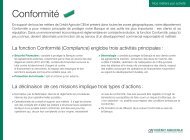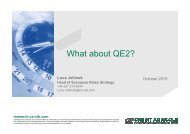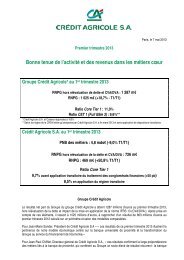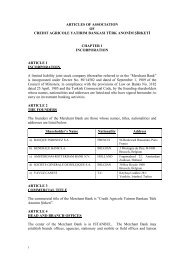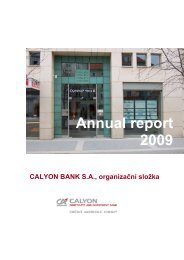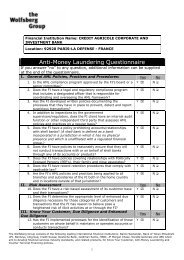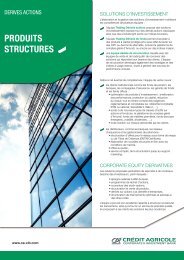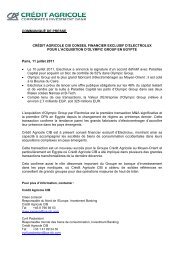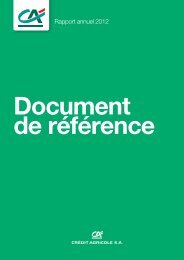ourexpertise - Crédit Agricole CIB
ourexpertise - Crédit Agricole CIB
ourexpertise - Crédit Agricole CIB
You also want an ePaper? Increase the reach of your titles
YUMPU automatically turns print PDFs into web optimized ePapers that Google loves.
2010 MANAGEMENT REPORT 3• Credit risk measurementThe measurement of credit risk exposures includes both drawnfacilities and confi rmed unutilized facilities. To measure counterpartyrisk on capital markets transactions, <strong>Crédit</strong> <strong>Agricole</strong> <strong>CIB</strong>uses an internal method for estimating the underlying risk of derivativefi nancial instruments such as swaps and structured products.The counterparty risk on markets transactions is subject to therecognition of potential risk arising from the change in market valueof derivatives instruments during their residual lifespan. Whenthe netting and collateralization agreements with the counterpartyallow, counterparty risk is measured for the portfolio net of eligiblecollateral. The corporate and investment business uses thismethod for the internal management of counterparty risk, and itdiffers from the regulatory approach used to meet the measurementrequirements of European, and international capital adequacyratios or for reporting majors risks.To reduce exposure to counterparty risks, the corporate and investmentbusiness enters into netting and collateralization agreementswith its counterparties (cf. paragraph 4. below: « Credit riskmitigation mechanism).Information on credit risks are provided in page 100 of the managementreport as well as in note 3 of the notes to the consolidatedfi nancial statements.Portfolio and concentration risksDecision-making and individual risk monitoring within <strong>Crédit</strong> <strong>Agricole</strong><strong>CIB</strong> are backed up by a portfolio risk monitoring system thatenables the group to assesscounterparty risks for its overall portfolio and for each of theconstituent sub-portfolios, according to a breakdown by businessline, sector, geographic zone, or any delineation that brings outspecifi c risk characteristics in the overall portfolio.Portfolio reviews are conducted periodically at each profi t centrein order to check that the portfolio is consistent with the riskstrategy in force, to assess the various segments of the portfolioagainst one another and against any aspects of the operatingenvironment or external impacts that may be infl uencing them,and fi nally to reassess the internal rating of the counterpartiesunder review.Different tools were implemented to detect any concentrationdeemed to be excessive for the entire portfolio, sub-portfolios orat a unit level:• Unit concentration scales were implemented to give referencepoints according to the nature, the size, the rating and the geographicarea of the counterparty. They are used in the loangrantingprocess and are periodically implemented to the entireportfolio to detect concentrations that seem to be excessive aposteriori.• The concentrations by sector or by geographic area are regularlythe subject of supervision, ad hoc analysis and when needed,of recommendations for action. In all cases, concentrationrisks are taken into account in the risk strategy analysis of eachbusiness line or geographic entity.<strong>Crédit</strong> <strong>Agricole</strong> <strong>CIB</strong> employs credit risk modelling tools and inparticular uses an internal portfolio model that calculates averageexpected loss, average loss volatility and unexpected loss,allowing it to estimate the economic capital required to conductits business. Average loss and volatility fi gures enable <strong>Crédit</strong> <strong>Agricole</strong><strong>CIB</strong> to anticipate the average risk-related cost in its portfolio,and changes therein. Economic capital is an additional measurementof Basel II regulatory capital, to the extent that it allowsa more detailed view of the portfolio using a correlation modeland parameters calibrated using internal databases. For example,economic capital is estimated by taking into account <strong>Crédit</strong> <strong>Agricole</strong><strong>CIB</strong>’s internal rating target rather than the 99.9% confi denceinterval required by Basel II.The internal portfolio model also takes into account the positiveimpact of protection (Credit Default Swaps, securitisations) purchasedby <strong>Crédit</strong> <strong>Agricole</strong> <strong>CIB</strong>’s Credit Portfolio Managementunit. Finally, it measures the effects of excessive concentration ordiversifi cation within our portfolio.Stress scenarios are the fi nal type of counterparty risk assessmenttool. They are regularly produced to estimate the impact ofextreme shocks on some or all of the portfolio.Sector risks<strong>Crédit</strong> <strong>Agricole</strong> <strong>CIB</strong>’s portfolio is analysed by major industrial sectorat regular intervals, at least once a quarter. Risks within eachsector in terms of commitments, level of risk (expected loss, economiccapital) and concentration are examined.Concentration is assessed on two levels: the sector’s weightingwithin <strong>Crédit</strong> <strong>Agricole</strong> <strong>CIB</strong>’s overall portfolio and the level of diversification within each sector.At the same time, the economic and fi nancial risks of each significant sector are analysed and leading indicators of deteriorationare monitored. These analysis are prepared with <strong>Crédit</strong> <strong>Agricole</strong>S.A’s specialists teams.Stress scenarios are also prepared where necessary.In the light of these various analyses, measures to diversify orprotect sectors at risk of deterioration are recommended.Country risksCountry risk is the risk that economic, fi nancial, political or socialconditions in a foreign country will affect the bank’s fi nancialinterests. It does not differ in nature from « elementary« risks(credit, market and operational risks). It constitutes a set ofrisks resulting from the bank’s vulnerability to a specifi c political,macroeconomic and fi nancial environment.The system for assessing and monitoring country risk within<strong>Crédit</strong> <strong>Agricole</strong> <strong>CIB</strong> is based on an internal rating model. Internalcountry ratings are based on criteria relating to the economy’sstructural solidity, ability to pay, governance and political stability.Annually reviewed limits and risk strategies are applied toeach country whose rating is lower than the threshold set byprocedures.In addition, the Bank performs scenario analyses to test adversemacroeconomic and fi nancial assumptions, which give anintegrated overview of the risks to which it may be exposed insituations of extreme tension.The Group manages and controls its country risks according tothe following principles:• Activities exposed to country risk are defi ned and identifi edthrough the development and monitoring of analytical countrySHELF-REGISTRATION DOCUMENT CRÉDIT AGRICOLE <strong>CIB</strong> 2010 97



